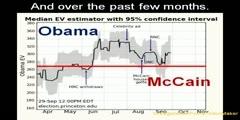Lec 13 - Demography and Asset Pricing: Will the Stock Market Decline when the Baby Boomers Retire?
"Lec 13 - Demography and Asset Pricing: Will the Stock Market Decline when the Baby Boomers Retire?" Financial Theory (ECON 251) In this lecture, we use the overlapping generations model from the previous class to see, mathematically, how demographic changes can influence interest rates and asset prices. We evaluate Tobin's statement that a perpetually growing population could solve the Social Security problem, and resolve, in a surprising way, a classical argument about the link between birth rates and the level of the stock market. Lastly, we finish by laying some of the philosophical and statistical groundwork for dealing with uncertainty. 00:00 - Chapter 1. Stationarity and Equilibrium in the Overlapping Generations Model 16:38 - Chapter 2. Evaluating Tobin's Thoughts on Social Security 35:07 - Chapter 3. Birth Rates and Stock Market Levels 01:02:30 - Chapter 4. Philosophical and Statistical Framework of Uncertainty Complete course materials are available at the Open Yale Courses website: http://open.yale.edu/courses This course was recorded in Fall 2009.
Video is embedded from external source so embedding is not available.
Video is embedded from external source so download is not available.
Here is the next lecture for this course
After the Failed Bailout and Stock Market ...
05:00 | 3501 viewsLec 22 - Risk Aversion and the Capital As ...
01:16:07 | 3138 viewsLec 23 - The Mutual Fund Theorem and Cova ...
01:16:05 | 3416 viewsLec 22 -Year 2008 - Stock Index, Oil and ...
01:10:35 | 3411 viewsLec 39 - Bailout 3: Book value vs. market ...
10:32 | 3744 viewsLec 40 - Bailout 4: Mark-to-model vs. mar ...
11:24 | 3655 viewsLec 170 - Futures Fair Value in the Pre-M ...
03:09 | 2876 viewsLec 3 - Bailout 3: Book value vs. market ...
10:32 | 2635 viewsLec 4 - Bailout 4: Mark-to-model vs. mark ...
11:24 | 2587 viewsLec 10 -Year 2008 - Debt Markets: Term St ...
01:10:45 | 4339 viewsLec 23 -Year 2008 - Options Markets
01:07:51 | 3143 viewsLec 4 - Portfolio Diversification and Sup ...
01:18:01 | 2829 viewsHow a Baby Develops in Mothers Womb
01:05 | 11128 viewsUltrasound of a 22 Week Old Baby
03:38 | 39775 viewsBaby orphans and wounded monkeys
03:24 | 8581 viewsNo content is added to this lecture.
This video is a part of a lecture series from of Yale
Lecture list for this course
Lec 2- Utilities, Endowments, and Equilibrium
Lec 4- Efficiency, Assets, and Time
Lec 5- Present Value Prices and the Real Rate of Interest
Lec 6 - Irving Fisher's Impatience Theory of Interest
Lec 7 - Shakespeare's Merchant of Venice and Collateral, Present Value and the Vocabulary of Finance
Lec 8 - How a Long-Lived Institution Figures an Annual Budget. Yield
Lec 10 - Dynamic Present Value
Lec 12 - Overlapping Generations Models of the Economy
Lec 14 - Quantifying Uncertainty and Risk
Lec 15 - Uncertainty and the Rational Expectations Hypothesis
Lec 16 - Backward Induction and Optimal Stopping Times
Lec 17 - Callable Bonds and the Mortgage Prepayment Option
Lec 18 - Modeling Mortgage Prepayments and Valuing Mortgages
Lec 19 - History of the Mortgage Market: A Personal Narrative
Lec 21 - Dynamic Hedging and Average Life
Lec 22 - Risk Aversion and the Capital Asset Pricing Theorem
Lec 23 - The Mutual Fund Theorem and Covariance Pricing Theorems
Lec 24 - Risk, Return, and Social Security
Lec 25 - The Leverage Cycle and the Subprime Mortgage Crisis
















